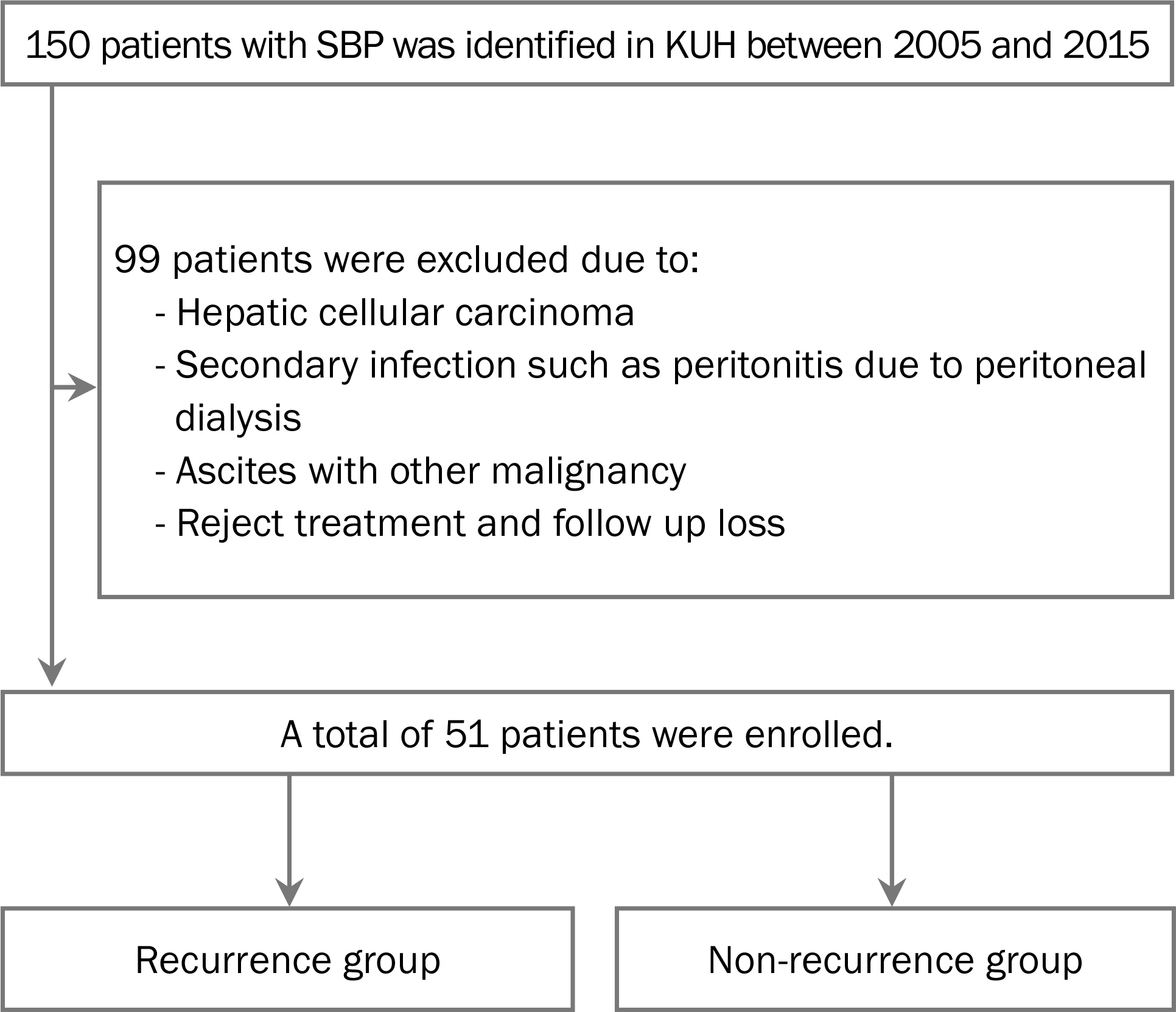Korean J Gastroenterol.
2017 Feb;69(2):129-134. 10.4166/kjg.2017.69.2.129.
Clinical Features of Spontaneous Bacterial Peritonitis: A 10-year Experience from a Single Center
- Affiliations
-
- 1Department of Internal Medicine, Konkuk University School of Medicine, Seoul, Korea. 93haan@hanmail.net
- KMID: 2383422
- DOI: http://doi.org/10.4166/kjg.2017.69.2.129
Abstract
- BACKGROUND/AIMS
Spontaneous bacterial peritonitis (SBP) is one of critical complications in liver cirrhosis patients with ascites. We aimed to review clinical course of SBP patients in a 10-year period from single center.
METHODS
This study enrolled SBP patients between 2005 and 2015. Their medical records were reviewed. The laboratory findings of serum and ascites were examined, and characteristics of isolated microorganisms in ascites were analyzed.
RESULTS
Total 51 patients were enrolled. Male patients were predominant (64.7%), and mean age was 59.20 years. The most common etiology of cirrhosis was alcohol (41.2%), followed by hepatitis B (39.2%). Microorganism was isolated from the ascites in 31 patients (60.78%). The proportions of Gram negative and Gram positive were 80.64% and 19.36%. The proportions of Escherichia coli, Klebsiella, and Streptococcus species were 29.41%, 19.61% and 11.76%. Among Escherichia colis, 4 cases were ESBL positive (7.84%). The most commonly used first-line antibiotic was cefotaxime (80.40%). Prophylactic antibiotics treatment was performed only in 8 patients, and SBP was recurred in 7 patients (13.72%). When comparing the SBP recurrence group and the non-recurrence group, there were no significant differences in laboratory findings of serum and ascitic fluid.
CONCLUSIONS
SBP is still a critical complication in cirrhosis patients with ascites, and the clinical features of SBP have not been altered much compared with those in 1990's. The effective treatment of SBP is still very important for a better prognosis of cirrhosis patients.
Keyword
MeSH Terms
Figure
Cited by 1 articles
-
Do We Need to Change the Treatment Strategy for Spontaneous Bacterial Peritonitis in Patients with Advanced Cirrhosis?
Chang Wook Kim
Korean J Gastroenterol. 2017;69(2):93-95. doi: 10.4166/kjg.2017.69.2.93.
Reference
-
References
1. Runyon BA. AASLD. Introduction to the revised American Association for the Study of Liver Diseases Practice Guideline management of adult patients with ascites due to cirrhosis 2012. Hepatology. 2013; 57:1651–1653.
Article2. Suk KT, Baik SK, Yoon JH, et al. Revision and update on clinical practice guideline for liver cirrhosis. Korean J Hepatol. 2012; 18:1–21.
Article3. Garcia-Tsao G. Ascites. Boyer TD, Wright TL, Manns MP, editors. Zakim and Boyer's hepatology, A textbook of liver disease. Volume 1. 5th ed.Philadelphia: Saunders & Elsevier;2006. p. 333–346.
Article4. Lee JM, Han KH, Ahn SH. Ascites and spontaneous bacterial peritonitis: an Asian perspective. J Gastroenterol Hepatol. 2009; 24:1494–1503.
Article5. Tito L, Rimola A, Gines P, Llach J, Arroyo V, Rodes J. Recurrence of spontaneous bacterial peritonitis in cirrhosis: frequency and predictive factors. Hepatology. 1988; 8:27–31.
Article6. Silvain C, Besson I, Ingrand P, Mannant PR, Fort E, Beauchant M. Prognosis and long-term recurrence of spontaneous bacterial peritonitis in cirrhosis. J Hepatol. 1993; 19:188–189.
Article7. Guarner C, Sola R, Soriano G, et al. Risk of a first community-acquired spontaneous bacterial peritonitis in cirrhosis with low ascitic fluid protein levels. Gastroenterology. 1999; 117:414–419.8. Fernandez J, Navasa M, Gomez J, et al. Bacterial infections in cirrhosis: epidemiological changes with invasive procedures and norfloxacin prophylaxis. Hepatology. 2002; 35:140–148.
Article9. Kerr DN, Pearson DT, Read AE. Infection of ascitic fluid in patients with hepatic cirrhosis. Gut. 1963; 4:394–398.
Article10. European Association for the Study of the Liver. EASL clinical practice guidelines on the management of ascites, spontaneous bacterial peritonitis, and hepatorenal syndrome in cirrhosis. J Hepatol. 2010; 53:397–417.11. Park MK, Lee JH, Byun YH, et al. Changes in the profiles of causative agents and antibiotic resistance rate for spontaneous bacterial peritonitis: an analysis of cultured microorganisms in recent 12 years. Korean J Hepatol. 2007; 13:370–377.
Article12. Song HG, Lee HC, Joo YH, et al. Clinical and microbiological characteristics of spontaneous bacterial peritonitis (SBP) in a recent five year period. Taehan Kan Hakhoe Chi. 2002; 8:61–70.13. Boixeda D, De Luis DA, Aller R, De Argila CM. Spontaneous bacterial peritonitis. Clinical and microbiological study of 233 episodes. J Clin Gastroenterol. 1996; 23:275–279.14. Dupeyron C, Campillo B, Mangeney N, Richardet JP, Leluan G. Changes in nature and antibiotic resistance of bacteria causing peritonitis in cirrhotic patients over a 20 year period. J Clin Pathol. 1998; 51:614–616.
Article15. Laroche M, Harding G. Primary and secondary peritonitis: an update. Eur J Clin Microbiol Infect Dis. 1998; 17:542–550.
Article
- Full Text Links
- Actions
-
Cited
- CITED
-
- Close
- Share
- Similar articles
-
- Post-traumatic primary bacterial peritonitis
- Spontaneous Bacterial Peritonitis due to Ochrobactrum anthropi: A Case Report
- A Prospective, Comparative Study of Two Methods of Ascitic Fluid Culture to Diagnose Spontaneous Bacterial Peritonitis.
- Two cases of spontaneous bacterial peritonitis in adults with nephrotic syndrome
- A case of spontaneous bacterial peritonitis and sepsis due to Pasteurella multocida in a patient with liver cirrhosis


